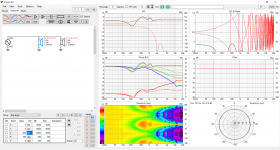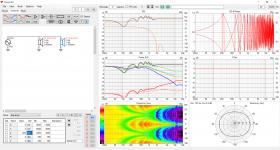I still say this would be awesome.
https://www.skaraudio.com/products/zvx-15v2-15-inch-car-subwoofer?variant=17690909697
https://www.skaraudio.com/products/zvx-15v2-15-inch-car-subwoofer?variant=17690909697
Im still thinking of living with modest Xmax as this can keep the MMs down and with strong BL and BL^2/Re I believe I will have a better transient response than adding MMs and longer travel suspension when I dont need much over 5mm at the lowest required frequencies that these will be driven at to get way above THX levels when combined with the 18's. I had a very interesting conversation with Bishopsound about how some of the more efficient low travel drivers sound in comparison to the high Xmax rubber surround drivers and think for the frequencies I am looking at they will be better and provide more 'punch'
Any guidance for parameters to compare drivers other than modelling, is the Qts is below 0.3 but they model Okay in a 90L box does that mean they are okay to use in a sealed 90L enclosure even if the manufacturer recommends ported or horn ?
When I model say a BMS 15N840 and a 18Sound ND930, they are not substantially different for example
When I model say a BMS 15N840 and a 18Sound ND930, they are not substantially different for example
Any more information on this is it just opposite firing
I have found that coupling the driver chassis by threaded rod through the mounting holes, works great. No discernible vibration to touch or ripples with a saucer of water sitting on top of a sub at high level testing.Magnets need to be physically connected or it wont work as well as it could....
//
Connecting the magnets is difficult to effect. As I see it, the woofer reaction into the cabinet is what requires cancelling and this is more efficiently done by opposed reaction at the cabinet.
https://www.diyaudio.com/community/...s-or-12s-in-16-cubed-box.391674/#post-7162084
Be aware that the radiation pattern from opposed reaction drivers is quite different from a single driver in an enclosure. On axis the drivers are acoustically out of phase and there will be a pressure minimum. The horizontal radiation pattern is more figure-of-eight rather than cardioid. Of course room boundaries will modify the in-room results.
^have you connected the drivers out of phase to make it dipole? Its not force cancelling then. its a bipole if its force cancelling, and when the drivers are relatively close together compared to wavelength its a monopole. 100Hz is 3.43m long and if drivers are ~80cm (1/4 wl) from each other its still roughly a monopole at 100Hz and below. 1/4wl separation means their phase difference to any direction is less than 90degrees and sum constructively. Conversely, one could build the sub so that driver spacing is 1/4wl to some frequency high enough the pattern is monopole for the intended working bandwidth, or deliberately plan for the bipole pattern as well why not.
edit. well, almost, 1/4wl difference or 90 degree phase means there is not much constructive interference anymore and technically response is already changing. Well, perhaps its all moot in room as modes rule 🙂 Anyway, 80cm spacing means that 100Hz is not perfectly omni anymore. This is sim of ideal ~10" driver on a 35cm square ideal baffle made in VCAD diffraction tool, then just doubled and positioned like in such sub, other driver rotated 180deg and then used Z offset to adjust spacing.



edit. well, almost, 1/4wl difference or 90 degree phase means there is not much constructive interference anymore and technically response is already changing. Well, perhaps its all moot in room as modes rule 🙂 Anyway, 80cm spacing means that 100Hz is not perfectly omni anymore. This is sim of ideal ~10" driver on a 35cm square ideal baffle made in VCAD diffraction tool, then just doubled and positioned like in such sub, other driver rotated 180deg and then used Z offset to adjust spacing.



Last edited:
Thanks for the sims. Although my comments were responding to questions about force cancelling, it is a bit off-topic. I will say though, that the difference in radiation pattern, may not be that important for multiple subs in a room, especially below 80Hz or so, and flexible sub locations. I am not a long term sub user, so I stand to be corrected.^have you connected the drivers out of phase to make it dipole? Its not force cancelling then.
I have compared in-phase drivers with out-of-phase drivers, with respect to enclosure vibration. The contrast was extreme. From 'nada' to 'walking' sub.
Hi, I realized my post lacks friendly tone and is even bit offensive, sorry about it. This is something I've been working on and posting in hurry seems something I should avoid.
Interesting topic, bipolar pattern of such config was something I had't inspected before so the above post is uncurated thoughts first and then sims to check it out, shoukd have added some conversational content to it as well 😀
Interesting topic, bipolar pattern of such config was something I had't inspected before so the above post is uncurated thoughts first and then sims to check it out, shoukd have added some conversational content to it as well 😀
I certainly think that the horizontal polar dispersion of opposed reaction force cancelling drivers is worth discussing, but may hijack the OP intentions. I will raise the issue in the current threadInteresting topic, bipolar pattern of such config was something I had't inspected before so the above post is uncurated thoughts first and then sims to check it out, shoukd have added some conversational content to it as well 😀
https://www.diyaudio.com/community/...s-or-12s-in-16-cubed-box.391674/#post-7162084
Hi,
yes its important to acknowledge but question is what are we after? Changing pattern of a source is usually done to affect sound at listening position somehow, and with subs we are on room modal region. Pattern can have some effect on sound but not sure if few decibels do much.
On a subwoofer application the distance of drivers needs to be quite big to have effect on the pattern (bipole) on the pass band, to have effect how room modes get activated I think. If we have great distance between drivers it then negates the force cancelling the drivers being too far apart, assuming best force cancellation happens magnets coupled, drivers very close to each other.
For this reason it would be more logical to have them drivers close together to have good force cancellation and then use another box other side of the room and have both, force cancellation and affect sound at listening position.
Perhaps there is some benefits higher up in frequency? I don't see what they are currently though.
edit. perhaps there is application on a double bass array, where for example 4 low frequency sources need to be on a front (and back) wall roughly 1/4 point on any length of the wall. For 8 foot tall front wall, make two 4 foot "tall" force cancelling subs and hang them 2 feet up flush against the wall, each end is now at 1/4 way of the height and should suit the DBA setup. Not sure how much force cancelling happens, perhaps enough. Could be more convenient to build two "pillars" standing on floor than 4 conventional subs somehow hung on the wall / in wall.
https://www.audiosciencereview.com/...of-the-double-bass-array-configuration.37943/
yes its important to acknowledge but question is what are we after? Changing pattern of a source is usually done to affect sound at listening position somehow, and with subs we are on room modal region. Pattern can have some effect on sound but not sure if few decibels do much.
On a subwoofer application the distance of drivers needs to be quite big to have effect on the pattern (bipole) on the pass band, to have effect how room modes get activated I think. If we have great distance between drivers it then negates the force cancelling the drivers being too far apart, assuming best force cancellation happens magnets coupled, drivers very close to each other.
For this reason it would be more logical to have them drivers close together to have good force cancellation and then use another box other side of the room and have both, force cancellation and affect sound at listening position.
Perhaps there is some benefits higher up in frequency? I don't see what they are currently though.
edit. perhaps there is application on a double bass array, where for example 4 low frequency sources need to be on a front (and back) wall roughly 1/4 point on any length of the wall. For 8 foot tall front wall, make two 4 foot "tall" force cancelling subs and hang them 2 feet up flush against the wall, each end is now at 1/4 way of the height and should suit the DBA setup. Not sure how much force cancelling happens, perhaps enough. Could be more convenient to build two "pillars" standing on floor than 4 conventional subs somehow hung on the wall / in wall.
https://www.audiosciencereview.com/...of-the-double-bass-array-configuration.37943/
Last edited:
- Home
- Loudspeakers
- Subwoofers
- Thinking of building some sealed 15" subs, value thoughts on drivers